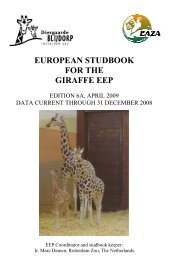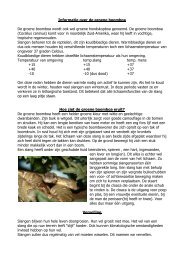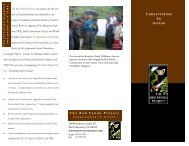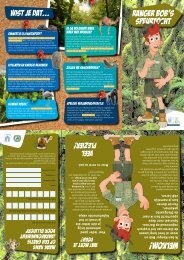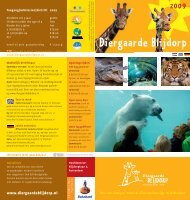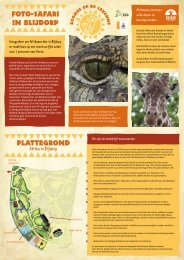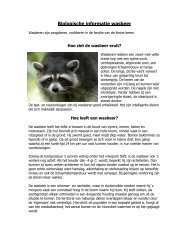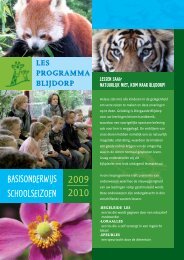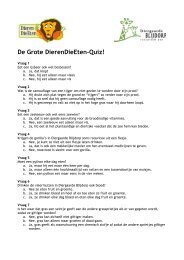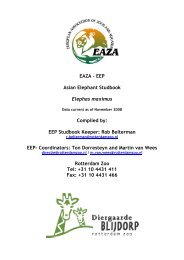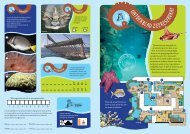You also want an ePaper? Increase the reach of your titles
YUMPU automatically turns print PDFs into web optimized ePapers that Google loves.
<strong>EEP</strong> STUDBOOK CROWNED PIGEONS<br />
Comparison with “natural” situation<br />
Burgers’ Bush gives the crowned <strong>pigeon</strong>s the most possibilities to conduct the behaviour they<br />
want. This enclosure has all elements of the other enclosures, and more. The time spent on<br />
conducting behaviour in time, “care”-behaviour and metabolic behaviour decreases if the<br />
enclosure is larger and more varied. In the more natural environment of Burgers’ Bush, the<br />
crowned <strong>pigeon</strong>s spent more time conducting social behaviour. But this also can be explained<br />
by the fact that these birds were incubating an egg.<br />
Correlation between male and female<br />
The behaviour of the male and the female are correlated in many types of behaviour. Only if<br />
the birds were incubating an egg, there was no correlation, which can be explained by the fact<br />
that incubating is a solitary activity.<br />
The metabolic behaviour was highly correlated; after feeding time, both birds started to eat. In<br />
Burgers’ Bush this correlation was less, because food was available all day.<br />
In some enclosures the behaviour was also correlated, probably because the birds would like<br />
to build a nest and they were looking together for nesting material.<br />
In Rotterdam Zoo the behaviour of the male and the female were also highly correlated, but<br />
this can be explained by the small enclosure-size.<br />
Use of the substrate<br />
With use of a Fishers Exact Test it became clear that crowned <strong>pigeon</strong>s have a preference for<br />
foraging on the mould and preening on the sand. In most enclosures the mould was planted<br />
and regularly leaves felled down, which were studied well by the birds. Furthermore the<br />
texture of the mould is different and the birds had to go with their bill into the mould to find<br />
out if there was something to eat. In sand this is not necessary. Also the mould can be<br />
considered as a place where food can be found, while the sand might be an open spot in the<br />
forest, where the crowned <strong>pigeon</strong> has a lot of space to preen. Both foraging and preening are<br />
important to the birds. If foraging is replaced by preening, they are preening too much which<br />
causes damages onto their feathers. The birds in Rotterdam Zoo looked worse than their<br />
congeners who had also mould available.<br />
Discussion about the results<br />
Experimental research project<br />
In the experiment with perches, where at random a thick and a thin perch was placed, four out<br />
of six crowned <strong>pigeon</strong> showed no preference for one of the types of perches, while the other<br />
two crowned <strong>pigeon</strong>s preferred the thick one. The hypothesis, formulated after research<br />
carried out in Burgers’ Bush (where the birds can choose between thousands of perches), was<br />
that crowned <strong>pigeon</strong>s should prefer thin branches, where they are better capable to bow their<br />
toes for a better grip. The strange results (in comparison with the hypothesis) can be explained<br />
by the fact that crowned <strong>pigeon</strong>s are very susceptible to changes in their environment. It<br />
always lasted several days for them to get used to something new, and in Birdpark Avifauna it<br />
even lasted seven weeks!<br />
110



